Validation of Human Body FE Models Under Impact Conditions
(Human Knee)
-
Three sets of test results on cadaver knee have been reported in
literature. The legforms, dummies and mathematical models do not
validate under all these three test conditions. A computational
model such as THUMS can be expected to validate under multiple
boundary conditions. This work involves validation of the FE model
of knee obtained from THUMS against all these three test conditions.
The mesh in THUMS has been modified to obtain the FE model
corresponding to that of a pedestrian. Validation under the test
conditions used by Kajzer et al (1999) and shearing test conditions
used by Kajzer et al (1997) has been achieved. The FE model also
validates against the four point bending test condition used by
Kerrigan et al (2003). The work also focused on the injury process
of knee. The injuries in simulations for all test conditions agreed
well with the respective autopsy results. It was also found that
scaled FE models of knee do not validate against the test
conditions.
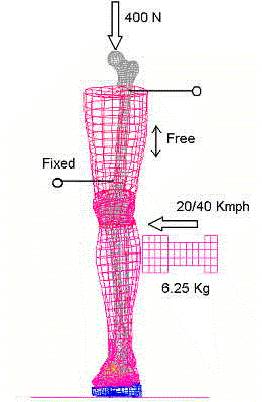 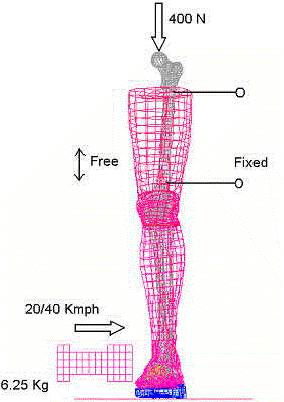
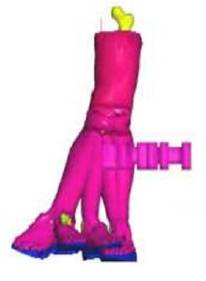
Super imposed view of knee
Figure 1: Knee
shear and bending test set up (Kajzer et al., 1997, 1999) modeled for
simulations
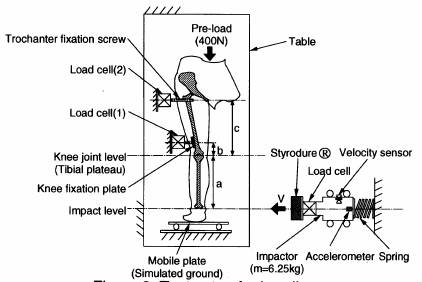
Figure
2 : Bending test set up (Kajzer
et al., 1999)
-
Finite Element
simulation of a lower extremity model is used to (1) determine which
of the muscle parameters maximum force capacity (Fmax), initial
activation levels (Na) and maximum muscle contraction velocity (Vmax)
affect ligament strains the most and (2) to identify which muscles
affect the knee response the most in low speed, just below the knee,
lateral impact. Simulations have been performed with Fmax, Na and
Vmax varying from their reference values. Sensitivity of ligament
strains to variation in muscle parameters has been studied. It is
observed that knee response is more sensitive to Fmax and Na than
Vmax. Amongst the muscles varied, reduction in the Fmax and the Na
in the hamstring and the gastrocnemius muscles affects the knee
ligament strains the most. The hamstring parameters significantly
affects the ACL, the PCL as well as the MCL strains whereas, change
in the gastrocnemius parameters affects only the MCL strain.
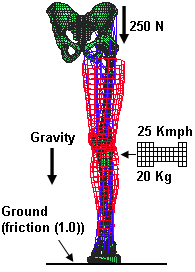
Figure 3 : Simulation set up used in the present
study (Soni A et al., 2009)
-
A full body
pedestrian model with active muscles has been developed. FE
simulations have been conducted using the full body model and
front structures of a car. Two preimpact conditions, that of a
symmetrically standing pedestrian representing a cadaver and an
unaware pedestrian have been simulated. Stretch based reflexive
action was included in the simulations for an unaware pedestrian.
Results show that due to muscle contraction (1) peak strains in
all the knee ligaments reduce (2) VonMises stresses in tibia and
fibula increase to their ultimate stress limits and are predicted
to fail and (3) knee joint effective stiffness increases by 67% in
lateral bending.
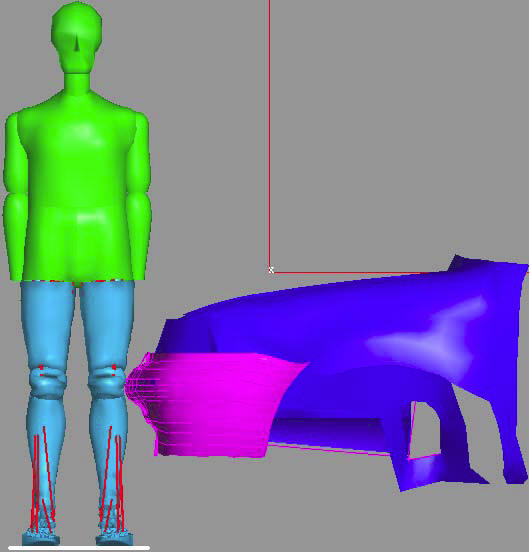
Figure 4 : Simulation set up used in the present
study showing the PMALE and FE model of the car front (Soni A et
al., 2008)
-
Unlike car occupants,
pedestrian crashes occur in a variety of postures (like
stationary, walking, running or jogging etc). Muscle contraction,
required to maintain the initial posture, modifies the load at the
knee joint in rapid loading conditions. This study investigates
the effect of muscle active forces on lower extremity injuries for
various impact locations and impact angles for a freely standing
pedestrian. Three different pre-impact conditions of a freely
standing pedestrian, representing a cadaver, an unaware and an
aware braced pedestrian, have been simulated for each impact
orientation. Stretch based reflexive action was included in the
simulations for an unaware pedestrian. It is concluded that strain
in knee ligaments is dependant on impact locations and angles and
the MCL is the most vulnerable ligament. Further, due to muscle
effects, except when the impact is on the knee, peak strain values
in all the ligaments are lower for an unaware pedestrian than
either for a cadaver or for a fully braced pedestrian.
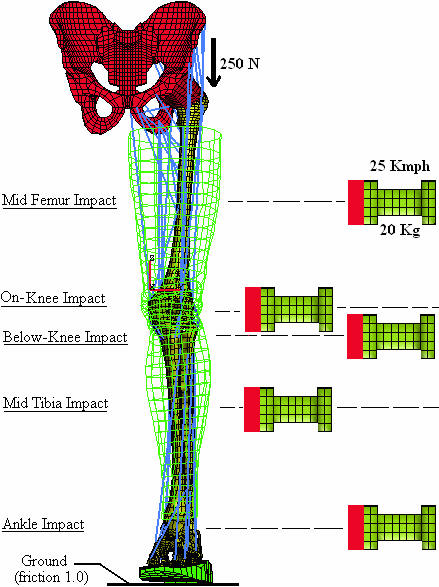 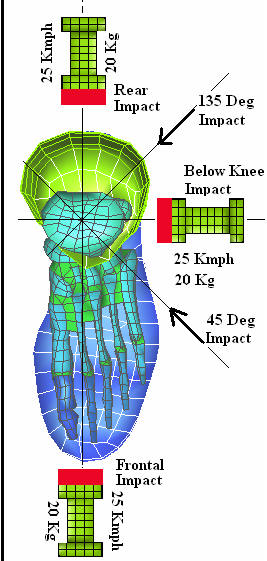
Figure 5 : Simulation set up to study the effects
of muscle forces in a freely standing pedestrian for five impact
locations(left) and four impact angles at below knee level (right)
(Chawla A et al.,2007)
-
Three variables, viz.
height of impact, pedestrian offset with respect to car centre and
impact speed, have been considered here. Full scale car pedestrian
FE simulations have been performed using the full body pedestrian
model with active lower extremities (PMALE) and front structures
of a car model. Two pre-impact conditions of a symmetrically
standing pedestrian, representing a cadaver and an unaware
pedestrian have been simulated. It is concluded that (1) with
muscle contraction risk of ligament failure decreases whereas risk
of bone fracture increases (2) ligament and bone strains are
dependent on the impact location (3) chances of ligament injuries
are higher when the impact occurs near the outer corner of the car
(4) risk of bone fracture increases with speed (5) bone fracture
reduces the risk of ligament failure.
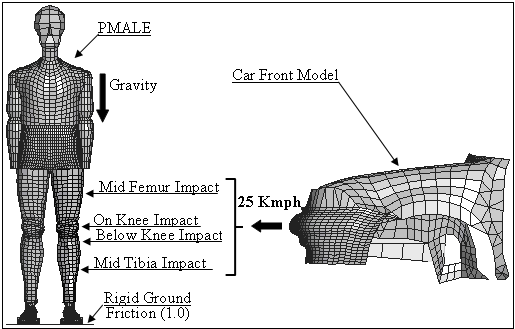 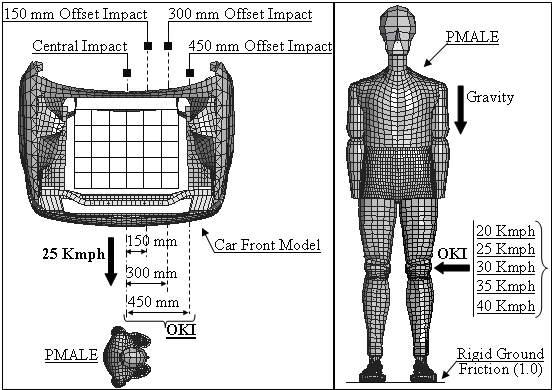
Figure 6 : Simulation setup to study
the effects of muscle forces in a symmetrically standing pedestrian
for (a) impact at four heights (b) four standing positions in front
of car and (c) five impact speeds
CLICK
HERE TO VIEW THE ANIMATION
People Involved:
Faculties:
- Dr. A. Chawla
- Dr. S. Mukherjee
Students and Staff:
|
List of Sponsored Projects:
|
Related Publication:
-
Soni A, Chawla A, Mukherjee S, Malhotra R,Sensitivity
Analysis of Muscle Parameters and Identification of
Effective Muscles in Low Speed Lateral Impact at Just below
the Knee submitted for SAE World Congress 2009.
-
Soni A., Chawla A, Mukherjee S., Malhotra R.
Response of lower extremity in car-pedestrian impact -
influence of muscle contraction Proceedings of IRCOBI
2008
-
Soni A, Chawla A, Mukherjee S, Effect of Muscle Contraction
on knee loading for a standing pedestrian in lateral
impacts, Proceedings of the Enhanced Safety of Vehicles
Conference 2007, Lyon, France, June 2007
-
Chawla A, Mukherjee S, Soni A, Malhotra R, Effect of active
muscle forces on knee injury risks for pedestrian standing
posture at low speed impacts, Proceedings of the IRCOBI 2007
conference, September 2007, Masstricht, Holland
-
Soni A, Chawla A and Mukherjee S, Effect of Active Muscle
Forces on the Response of knee Joint at Low Speed Lateral
Impacts, Proceedings of SAE 2006 World Congress.
-
A Chawla,
S Mukherjee,
D Mohan and A Parihar, Validation of lower exteremity model
in Thums, Proceedings of IRCOBI 2004,
Graz,
Austria, 2004.
-
Soni A, Chawla A, Mukherjee S, Malhora R, Response of tonic
lower limb FE model in various real life car-pedestrian
impact configurations – a parametric study for standing
posture, accepted for the International Journal of Vehicel
Safety.
-
Soni A, Chawla A, Mukherjee S, Malhora R, Response of lower
limb in full scale car-pedestrian low speed lateral impact-
Influence of muscle contraction, accepted for International
Journal of Crashworthiness
|
|
|
|
TOP
|
|